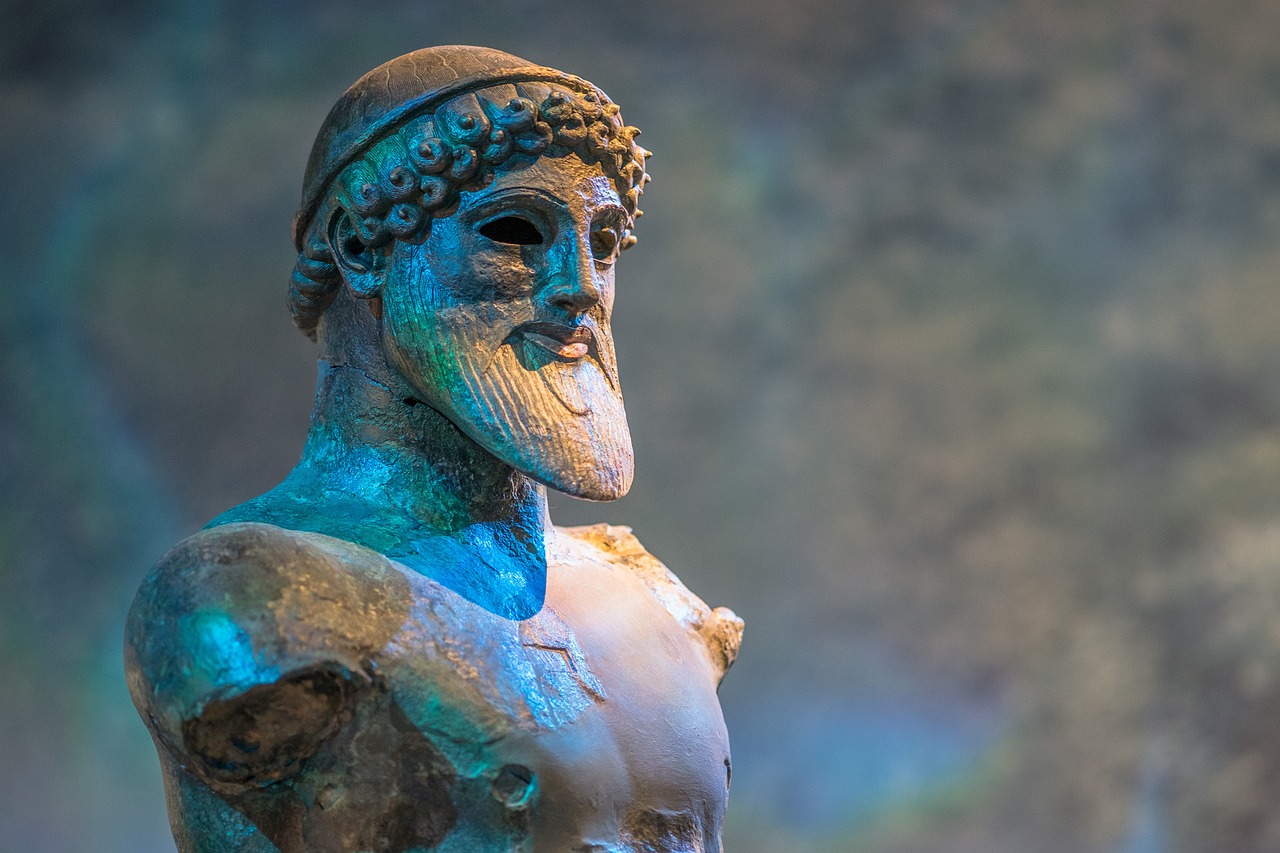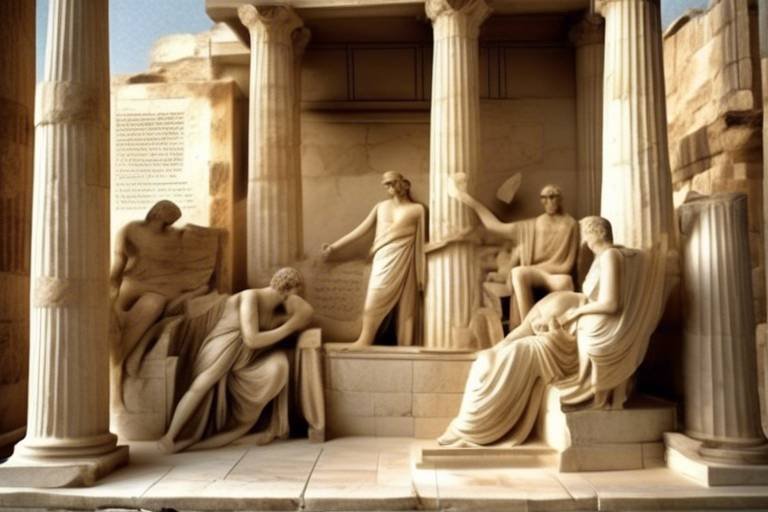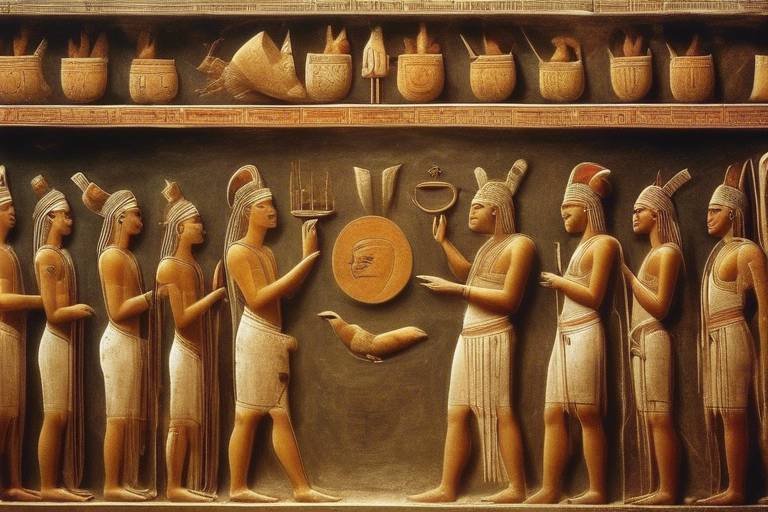The Significance of Artifacts in Understanding Ancient Societies
Exploring how artifacts provide valuable insights into the cultures, beliefs, technologies, and daily lives of ancient societies, shedding light on their customs, social structures, and historical developments.
Artifacts serve as windows into the past, offering a glimpse into the intricate tapestry of ancient civilizations. These tangible remnants of bygone eras hold stories of triumphs, struggles, and innovations, allowing us to unravel the mysteries of societies long lost to time. Through careful examination and interpretation, archaeologists piece together the puzzle of human history, using artifacts as their guide.
From the humble tools used for hunting and farming to the exquisite jewelry adorning royalty, each artifact tells a unique tale of its creators. The pottery fragments whisper secrets of daily life, while religious objects unveil the spiritual beliefs and practices of ancient cultures. These artifacts not only showcase the craftsmanship and skills of their makers but also provide a deeper understanding of the values and traditions that shaped their world.
Preserving these artifacts poses a significant challenge, requiring meticulous care and conservation efforts to protect them for future generations. Archaeologists, museums, and experts in the field play a crucial role in safeguarding these treasures, ensuring that they remain intact and accessible for study and appreciation. Through advanced techniques and technologies, these artifacts are carefully preserved, allowing us to continue learning from the past.
Symbolism lies at the heart of many artifacts, with each object carrying layers of meaning and significance. Whether it be a ceremonial mask, a decorative ornament, or a ritualistic tool, these artifacts were often imbued with symbolic representations of the spiritual, social, and cultural aspects of ancient societies. By decoding these symbols, researchers can unravel the complex web of beliefs and practices that defined these civilizations.
Trade and exchange played a pivotal role in the ancient world, and artifacts provide valuable evidence of the interconnectedness of different societies. Through the study of trade routes, exchange networks, and imported goods, historians can trace the flow of commodities, ideas, and technologies across vast distances. These artifacts serve as tangible links between cultures, showcasing the diversity and richness of ancient interactions.
Artifacts serve not only as relics of the past but also as historical records that offer direct insights into the material culture of ancient civilizations. Through the examination of everyday objects, tools, and structures, researchers can reconstruct the daily lives, practices, and innovations of these societies. Each artifact acts as a piece of the larger puzzle, contributing to our understanding of the past.
Technological advancements are often reflected in the artifacts left behind by ancient societies, showcasing their ingenuity and creativity. From intricate metalwork to sophisticated pottery techniques, these artifacts highlight the innovative spirit of past civilizations. By studying these technological achievements, we gain a deeper appreciation for the skills and knowledge possessed by our ancestors.
Artifacts play a crucial role in shaping the identities of ancient societies, reflecting their sense of heritage, belonging, and cultural pride. Whether through elaborate tombs, symbolic artifacts, or monumental structures, these objects define the narratives of civilizations past. By studying these artifacts, we not only learn about the past but also connect with the shared humanity that binds us across time and space.
Controversies and debates often surround the interpretation and ownership of artifacts, raising ethical considerations and cultural heritage issues in modern society. The question of who owns the past and how artifacts should be displayed and preserved sparks heated discussions among scholars, policymakers, and the public. Balancing the need for research and preservation with respect for cultural sensitivities remains a complex challenge in the field of archaeology.

Types of Artifacts
When delving into the world of ancient societies, artifacts play a crucial role in unraveling the mysteries of the past. These tangible remnants offer a glimpse into the lives, beliefs, and technologies of civilizations long gone, providing invaluable insights for historians and archaeologists alike.
Artifacts come in various forms, each with its own story to tell. From tools used in daily life to intricately crafted pottery, from ornate jewelry to sacred religious objects, these artifacts offer a diverse range of perspectives on the customs and practices of ancient societies.
Exploring the types of artifacts reveals the intricate web of traditions and innovations that characterized different cultures. Tools speak of practicality and craftsmanship, pottery reflects artistic expression and utility, jewelry showcases adornment and status, while religious objects offer a window into spiritual beliefs and practices.
Furthermore, the study of artifacts sheds light on the skills and technologies that ancient societies possessed. By examining the materials, techniques, and designs used in crafting these objects, researchers can uncover the level of sophistication and ingenuity achieved by our ancestors.
Moreover, artifacts not only serve as historical artifacts but also as cultural symbols. They embody the values, beliefs, and identities of ancient civilizations, acting as tangible links to the past and shaping our understanding of who they were and how they lived.
Through the exploration of various types of artifacts, we are able to piece together the puzzle of ancient societies, gaining a deeper appreciation for the richness and complexity of human history.

Artifact Preservation
Artifact preservation is a critical aspect of safeguarding the rich history and cultural heritage encapsulated within ancient artifacts. Over time, these artifacts face numerous challenges that threaten their integrity and longevity. Archaeologists and museums play pivotal roles in the preservation process, employing various conservation techniques to ensure that these valuable historical objects are protected for future generations to study and appreciate.
One of the primary challenges in artifact preservation is the threat of deterioration due to environmental factors such as exposure to light, humidity, temperature fluctuations, and even microbial growth. These factors can cause irreversible damage to artifacts if not properly controlled and managed. Museums often employ controlled storage environments and display conditions to mitigate these risks and prolong the lifespan of the artifacts.
Conservation techniques such as cleaning, stabilizing fragile materials, and repairing damage are essential practices in artifact preservation. Conservation specialists carefully assess the condition of artifacts and develop tailored treatment plans to address specific issues while adhering to ethical standards and principles of cultural heritage preservation.
Additionally, proper documentation of artifacts is crucial for their preservation. Detailed records including photographs, measurements, material analysis, and historical context provide valuable information for researchers and future conservation efforts. By documenting artifacts comprehensively, their significance and cultural context can be preserved alongside the physical object.
Furthermore, public awareness and education about the importance of artifact preservation are vital in fostering a sense of responsibility and stewardship towards our shared cultural heritage. Through outreach programs, exhibitions, and educational initiatives, museums and heritage organizations aim to engage the public in understanding the value of preserving artifacts for the benefit of present and future generations.

Symbolism and Meaning
Exploring how artifacts provide valuable insights into the cultures, beliefs, technologies, and daily lives of ancient societies, shedding light on their customs, social structures, and historical developments.
Discussing the various categories of artifacts such as tools, pottery, jewelry, and religious objects, each offering unique perspectives on different aspects of ancient societies.
Exploring the challenges of preserving artifacts over time, including the role of archaeologists, museums, and conservation techniques in safeguarding these valuable historical objects.
Artifacts in ancient societies were often imbued with symbolic meanings, reflecting the spiritual, social, and cultural significance attributed to them. These symbols provided insights into the values and beliefs held by these civilizations, offering a window into their worldview and ideologies.
Examining how artifacts can provide evidence of ancient trade networks, economic systems, and cultural interactions between different societies and regions.
Highlighting the role of artifacts as tangible records of history, offering direct insights into the material culture and practices of ancient civilizations.
Discussing how artifacts can reveal the technological advancements achieved by ancient societies, showcasing their innovations in craftsmanship, engineering, and other fields.
Exploring how artifacts can shape and reflect the identities of ancient societies, influencing their sense of belonging, heritage, and cultural pride.
Addressing the controversies and debates surrounding the interpretation and ownership of artifacts, including ethical considerations and cultural heritage issues in modern society.
1. Why are artifacts important in understanding ancient societies?
Artifacts provide tangible links to the past, offering direct insights into the daily lives, beliefs, and technologies of ancient civilizations.
2. How do archaeologists preserve artifacts?
Archaeologists use specialized techniques such as documentation, conservation, and storage to ensure the long-term preservation of artifacts.
3. What role do museums play in safeguarding artifacts?
Museums serve as custodians of cultural heritage, displaying and protecting artifacts for future generations to study and appreciate.
4. Why is the symbolism of artifacts important?
The symbolism of artifacts helps us understand the cultural values, beliefs, and social structures of ancient societies, providing valuable insights into their worldview.
5. What are some common controversies surrounding artifacts?
Controversies often arise over the ownership, repatriation, and ethical considerations related to artifacts, especially concerning cultural heritage and indigenous rights.

Trade and Exchange
Exploring how artifacts provide valuable insights into the cultures, beliefs, technologies, and daily lives of ancient societies, shedding light on their customs, social structures, and historical developments.
Discussing the various categories of artifacts such as tools, pottery, jewelry, and religious objects, each offering unique perspectives on different aspects of ancient societies.
Exploring the challenges of preserving artifacts over time, including the role of archaeologists, museums, and conservation techniques in safeguarding these valuable historical objects.
Analyzing how artifacts were often imbued with symbolic meanings, reflecting the spiritual, social, and cultural significance attributed to them by ancient societies.
Trade and exchange were fundamental aspects of ancient societies, shaping their economies and cultural interactions. Artifacts play a crucial role in providing evidence of these trade networks, revealing the economic systems and connections between different regions. Through artifacts like pottery, coins, and exotic goods found in archaeological sites, we can trace the routes of ancient merchants and understand the cultural exchanges that occurred.
Highlighting the role of artifacts as tangible records of history, offering direct insights into the material culture and practices of ancient civilizations.
Discussing how artifacts can reveal the technological advancements achieved by ancient societies, showcasing their innovations in craftsmanship, engineering, and other fields.
Exploring how artifacts can shape and reflect the identities of ancient societies, influencing their sense of belonging, heritage, and cultural pride.
Addressing the controversies and debates surrounding the interpretation and ownership of artifacts, including ethical considerations and cultural heritage issues in modern society.

Artifacts as Historical Records
Artifacts serve as invaluable historical records, offering direct insights into the material culture and practices of ancient civilizations. These tangible objects provide a window into the past, allowing us to piece together the daily lives, beliefs, and technological advancements of ancient societies. By studying artifacts, historians and archaeologists can reconstruct the social structures, economic systems, and artistic achievements of bygone eras.
One of the key aspects of artifacts as historical records is their ability to transcend time and communicate across generations. Unlike written texts that may deteriorate or be lost, artifacts have the potential to endure for centuries, preserving a physical connection to the past. Through careful analysis and interpretation, these artifacts can reveal details about ancient trade routes, cultural exchanges, and artistic traditions that might otherwise be lost to history.
Furthermore, artifacts offer a more intimate understanding of ancient societies beyond what written records can provide. By examining tools, pottery, artwork, and everyday objects used by past civilizations, researchers can gain insights into the daily routines, religious practices, and technological achievements of these societies. Each artifact tells a story, shedding light on the customs, values, and innovations of the people who created and used them.
Moreover, artifacts as historical records play a crucial role in shaping our collective memory and understanding of the past. Museums and archaeological sites around the world house vast collections of artifacts that not only educate but also inspire curiosity and wonder. These physical remnants of ancient civilizations spark our imagination and curiosity, prompting us to delve deeper into the mysteries of history and appreciate the rich tapestry of human heritage.

Technological Advancements
Exploring how artifacts provide valuable insights into the cultures, beliefs, technologies, and daily lives of ancient societies, shedding light on their customs, social structures, and historical developments.
Discussing the various categories of artifacts such as tools, pottery, jewelry, and religious objects, each offering unique perspectives on different aspects of ancient societies.
Exploring the challenges of preserving artifacts over time, including the role of archaeologists, museums, and conservation techniques in safeguarding these valuable historical objects.
Analyzing how artifacts were often imbued with symbolic meanings, reflecting the spiritual, social, and cultural significance attributed to them by ancient societies.
Examining how artifacts can provide evidence of ancient trade networks, economic systems, and cultural interactions between different societies and regions.
Highlighting the role of artifacts as tangible records of history, offering direct insights into the material culture and practices of ancient civilizations.
Discussing how artifacts can reveal the technological advancements achieved by ancient societies, showcasing their innovations in craftsmanship, engineering, and other fields.
Exploring how artifacts can shape and reflect the identities of ancient societies, influencing their sense of belonging, heritage, and cultural pride.
Addressing the controversies and debates surrounding the interpretation and ownership of artifacts, including ethical considerations and cultural heritage issues in modern society.
Stay tuned for answers to common queries about artifacts, ancient societies, and historical preservation.

Artifacts and Identity
Artifacts play a crucial role in shaping the identity of ancient societies, serving as tangible expressions of their beliefs, values, and traditions. These objects not only reflect the material culture of a civilization but also hold deeper significance in defining the collective identity of a community. Just like how a family heirloom carries the memories and legacy of generations, artifacts connect ancient societies to their past, anchoring them in a shared history that shapes their sense of belonging and cultural pride.
Imagine a beautifully crafted piece of jewelry worn by a noblewoman in an ancient civilization. This artifact not only signifies her social status and wealth but also embodies the craftsmanship and artistic skills of her society. Through such artifacts, we can glimpse into the aesthetic preferences, cultural practices, and societal hierarchies of ancient communities, painting a vivid picture of their identity and values.
Moreover, artifacts can act as symbols of cultural continuity, bridging the gap between the past and the present. Just as a national flag represents the identity and unity of a modern nation, artifacts symbolize the shared heritage and collective memory of ancient societies. These objects serve as reminders of where we come from, grounding us in our roots and preserving the legacy of those who came before us.
Artifacts also hold the power to evoke emotions and foster a sense of connection with our ancestors. When we gaze upon a meticulously crafted pottery piece or a religious artifact from an ancient civilization, we are transported back in time, feeling a kinship with those who created and used these objects. In this way, artifacts not only shape the identity of ancient societies but also allow us to forge a deeper connection with our own cultural heritage.

Controversies and Debates
Controversies and debates surrounding artifacts are not uncommon in the field of archaeology and cultural heritage. One of the major issues often discussed is the ownership of artifacts, especially those removed from their countries of origin during colonial periods. The question of whether these artifacts should be repatriated to their places of origin or remain in museums in other countries sparks heated debates among scholars, governments, and indigenous communities.
Furthermore, ethical considerations come into play when dealing with artifacts that have been looted or illegally acquired. The ethical dilemma of displaying such artifacts in museums raises questions about the responsibility of institutions in ensuring the ethical sourcing and display of cultural heritage objects. Balancing the educational value of displaying these artifacts with the ethical concerns of their origins is a complex and ongoing debate.
Another controversial issue is the interpretation of artifacts and the narratives they convey. Different interpretations of the same artifact can lead to conflicting historical narratives, challenging the established understanding of ancient societies. Scholars and experts often engage in debates over the significance and meaning of artifacts, highlighting the subjective nature of interpreting material culture.
Moreover, the commercialization of artifacts through the antiquities market raises concerns about the commodification of cultural heritage. The buying and selling of artifacts, especially those of significant historical value, can contribute to the loss of archaeological context and the illegal trafficking of cultural property. This issue prompts discussions on the regulation of the antiquities trade and the protection of cultural heritage from exploitation.
In conclusion, controversies and debates surrounding artifacts underscore the complex nature of studying and preserving ancient societies' material culture. Addressing these issues requires a multidisciplinary approach that considers ethical, legal, and cultural perspectives to ensure the responsible management and interpretation of artifacts for future generations.
Frequently Asked Questions
- What are artifacts?
Artifacts are objects made or modified by humans that provide valuable insights into ancient societies, including their cultures, technologies, and daily lives.
- Why are artifacts important in understanding ancient societies?
Artifacts offer direct evidence of past civilizations, shedding light on their customs, social structures, and historical developments, helping us piece together the puzzle of our human history.
- How do archaeologists preserve artifacts?
Archaeologists use various techniques such as proper excavation, documentation, and conservation methods to safeguard artifacts for future study and enjoyment.
- What do artifacts reveal about ancient trade networks?
Artifacts provide evidence of trade routes, economic systems, and cultural exchanges between different societies, showcasing the interconnectedness of ancient civilizations.
- Why do artifacts hold symbolic meanings?
Artifacts were often imbued with symbolic significance, reflecting the spiritual, social, and cultural values of the societies that created or used them.
- How do artifacts contribute to our understanding of ancient technological advancements?
By studying artifacts, we can uncover the technological innovations achieved by ancient societies, revealing their progress in craftsmanship, engineering, and other fields.
- What controversies surround artifacts today?
Modern debates revolve around the interpretation, ownership, and ethical considerations of artifacts, addressing issues of cultural heritage preservation and rightful ownership.



















